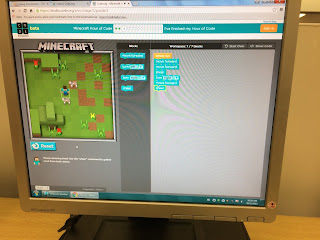Last week, during our tech time on the computers in the library, the students noticed that I was exploring The Hour of Code website. I was actually coding some Minecraft games and once they realized what I was doing, they were all over me!! They were very interested, they love Minecraft. All of a sudden I had students take over the controls until I regained the mouse and sent them back to their work stations with the promise that I would provide them with more information about what I was doing and what I would be planning for them.
A couple of days later I informed my students that we would be participating in The Hour of Code this year. Also, thanks to the website, I was able to connect with two University of Waterloo students who would be speaking to my students about coding/programming. One of the volunteers will be visiting us in class and the other will be joining us via Google Hangout.
So, why code? What's the big deal? First off, my students are interested. They have been talking to me about it for a while now. The group that I have this year are keen with respect to solving problems and being creative. Coding allows students to be creative, collaborative, problem solve, learn a new language, think logically, and have a lot of fun!! Being able to code/program is the way of the future - it will become common place so to start their journey now is appropriate.
We are only in the introductory phase, and like anything worth doing, we need time to play and experiment. All of this is new to us and we are taking the time to get used to things and gain some useful skills. Once we have a handle on what we are doing, I can begin to make solid connections to our curriculum and immerse the students in activities that will hold their interest and allow them to acquire the knowledge, understanding, and skills that will lead them to academic success.
We started playing today. I introduced my students to a few options that involved Star Wars, Minecraft, and Frozen. Using blocks of code/demands, they went on adventures and did some cool things that they weren't able to do before.
When the students started working on their chosen activity, I saw some really amazing things. First and foremost, they each had a computer to start their activities. But as time went on, I saw students start to
- work together to solve problems,
- grab pencils and papers to write out their ideas and logic - essentially leaving the computer to code without it,
- actually stand up and physically act out what they were going to do with their code
It was incredible. Actually, what was incredible is that they took the initiative to do what they needed to do to get the job done. All our talks about taking initiative, about being aware that there are a variety of ways to meet a goal, that it is ok to do things differently to get results, seemed to pay off. No one asked me to get pencil and paper, no one asked if they could problem solve with another student, no one asked if they could get up and move around! They had their task and they showed me that they could work on it in a way that would best suit their needs. This is precisely the culture that we are trying to grow in our classroom community and it was quite the reward for me to witness it.
Here are some photos of their work today:




















